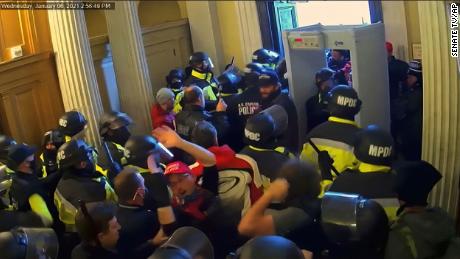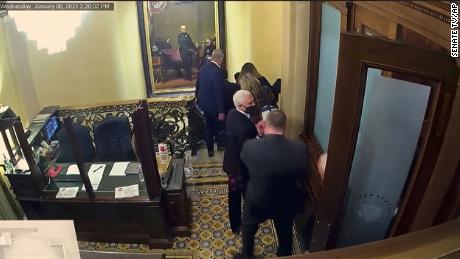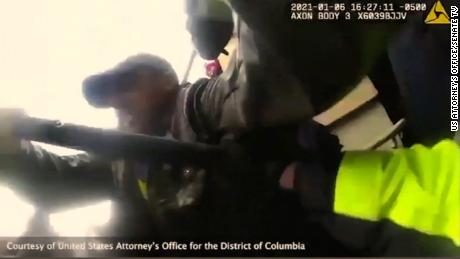By weaving together body camera footage and surveillance, managers prove it’s only by seeing that one can truly understand the horror
The managers constructed a powerful case against Trump by creating what amounted to a virtual reality of the January 6 events that each senator in the chamber was forced to experience. They sat as jurors at the very same desks that rioters rifled through, in a building that was desecrated. But this time, they watched the events unfold on video from the overlaying perspectives of the police officers who protected them, the rioters who came for them, and even their fellow members of Congress who were in fear of losing their lives.
The power of the presentation was derived from its unique three-dimensionality — one that never would have been possible before this age of cellphones where everything is documented and available in real time, giving the managers a massive trove of video and social media to work with.
Never before in history have Americans seen one attack on their nation from so many different perspectives. For hours, the managers outlined in painstaking detail what unfolded in each critical minute of the siege with timestamps — later played back against the President’s actions or inaction. Sometimes, they showed the same few minutes or seconds from the vantage point of two or three different videos to punctuate their arguments. The montages were brutal, searing and unforgettable.
With Trump charged with inciting the insurrection, Democrats carefully chronicled his actions leading up to the election and the insurrection, rolling the tape on his speeches and interviews, and throwing his tweets up on screen.
But they made an even more devastating case by chronicling his inaction as commander-in-chief during the most frightening moments of the siege with clips from Twitter, Parler and YouTube; cell phone footage from reporters and members of Congress; desperate police radio dispatches calling for backup; officer body camera footage that was marked as being obtained by the US attorney’s office; and an array of surveillance camera footage from across the Capitol that captured a bird’s-eye view of key moments.
Wielding the element of surprise by unearthing many previously unreleased videos, they showed the harrowing moments where then-Vice President Mike Pence, his wife and daughter, were rushed to safety down a narrow stairway on the Senate side of the Capitol. They juxtaposed that surveillance video from an overhead Capitol camera with a video shot from within the angry mob outside chanting “Hang Mike Pence!” — then crystallized the danger with a chilling photograph of a noose and a gallows that was erected that day outside the Capitol.
The managers tried to give it all context by showing Trump’s tweet attacking Pence two minutes before the vice president was evacuated down those steps — showing how the former President continued to whip up the anger of the crowd by falsely leading his followers to believe that Pence could somehow have stopped the certification of the electoral votes.
To rebut Trump’s defenders’ claims that he did not incite violence and had no bearing on the events that unfolded that afternoon, the managers then showed video of a Trump loyalist outside the Capitol reading the former President’s tweet accusing Pence of disloyalty in real time over a bullhorn as anger mounted.
There was fresh audio too: desperate police radio calls with one officer saying, “We’re surrounded,” warning that police were “taking projectiles.”
“Cruiser 50. They’ve breached the scaffolds,” an officer says over the radio his voice laced with distress. “Let Capitol know they have breached the scaffolds. They are behind our lines.”
And then every viewer of the trial, including those Senate jurors, felt what it was like within those blue lines watching police officers being beaten with fists, pipes and sticks from the stomach-turning perspective of a body-worn camera.
Rep. Joaquin Castro of Texas, one of the impeachment managers, noted that the January 6 attack, which killed five people, also led to the injuries of some 140 officers. One will lose an eye, he said. Others have broken ribs. One was stabbed with a metal fence stake. Through some of that body camera footage on Wednesday, trial viewers felt the chilling horror of those attacks on those officers’ lives — combat that one officer aptly described as “medieval.”
At another point, impeachment managers tried to portray the danger that staff members felt as House Speaker Nancy Pelosi was being hunted down by rioters who pounded on doors demanding to know where she was. They played a hushed recording of a phone call from one of Pelosi’s staffers after her aides had huddled under a table in an inner conference room behind a barricaded door. “They’re pounding the doors trying to find her,” the aide whispers into the phone. The bookend to the call was a video from minutes later, showing a rioter jamming his shoulder into an outer door and then breaking through near where they were hiding, before turning away.
The gunshot is heard, then a gasp of profanity capturing the fear in that moment: “Take your pins off,” members are heard telling one another. Swalwell noted that the buzzing sound in the background of the video emanated from the gas masks members were holding.
In their totality, the videos were gripping and provocative precisely because they showed the heights of Trump’s power, from the echoes of his words repeated back by his rioters to the way they captured the anger rippling through his mob as they marched through the Capitol looking to do harm in his name as they fought for his cause. They also showed what might have happened if the former President had acted differently that day.
“We won,” Chansley says.
![]()









